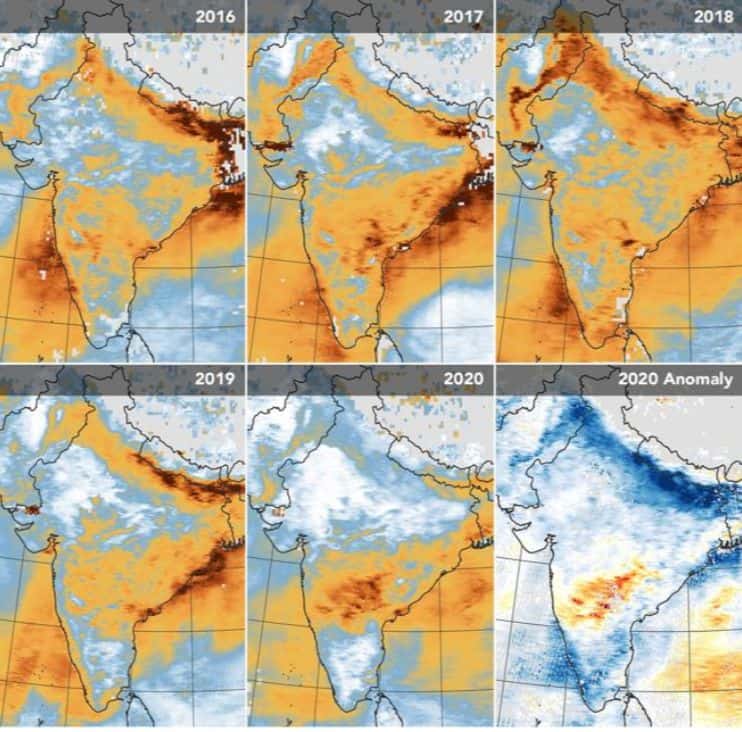The images provided by the satellites are showing in recent weeks the substantial improvement in air quality detected in various parts of the world as a consequence of the stoppage of traffic and industry during the confinement by Covid-19.
Images captured by NASA satellite sensors now show that confinement measures in India since March 25 (with some 1.3 billion people affected) show that air quality in many of the regions of this Asian country is now the best of at least the last 20 years.
Suspended particles from anthropogenic sources (generated by human activities) cause unhealthy levels of air pollution in many Indian cities.
These small polluting particles reduce visibility and can damage the human lungs and heart. Some aerosols have natural sources, such as dust storms, volcanic eruptions, and forest fires. Others come from human activities, such as burning fossil fuels and moving farmland. Particles produced by small human activities have a greater potential to harm health.
“We knew we would see changes in atmospheric composition in many places during the shutdown,” said Pawan Gupta, a scientist at the University Space Research Association (USRA) at NASA’s Marshall Space Flight Center. “But I have never seen such low aerosol values on the Indo-Gangetic Plain at this time of year.”


The data analyzed by NASA is summarized on six comparable maps. The first five maps above show Aerosol Optical Depth (AOD) measurements in India during the same period from March 31 to April 5 for each year from 2016 to 2020.
The sixth map (anomaly) shows how AOD in 2020 compared to the 2016-2019 average. The optical depth of the aerosol is a measure of how light is absorbed or reflected by particles in the air as it travels through of the atmosphere. If aerosols are concentrated near the surface, an optical depth of 1 or greater indicates very hazy conditions. An optical depth or thickness of less than 0.1 over the entire atmospheric vertical column is considered “clean”. Data was retrieved by the Moderate Resolution Imaging Spectroradiometer (MODIS) on NASA’s Terra satellite.
In a typical spring in the Ganges Valley in northern India, human activities generate most of the aerosols. Motor vehicles, coal power plants, and other industrial sources in urban areas produce nitrates and sulfates; The combustion of coal also produces soot and other carbon-rich particles. Rural areas add smoke, rich in black carbon and organic carbon, from cooking and heating stoves and from prescribed burns on farms (although farm fires occur more frequently at other times of the year). According to all reports, the close of 2020 reduced those man-made emission sources.

Scientists expect aerosol levels to rise slightly in the coming weeks in some parts of India as seasonal dust storms begin. Dust concentrations are typically low in March and early April before temperatures rise and strong westerly winds blow sand from the Thar Desert and the Arabian Peninsula. The question is whether overall AOD will remain below normal.
“The difficult part of understanding aerosols is that the particles can move based on wind patterns and other weather,” said Robert Levy, leader of NASA’s MODIS aerosol product program. “You have to untangle what is caused by the human versus a weather factor.”
In the first days of closing, it was difficult to observe a change in the contamination signature. “We saw a decrease in aerosol in the first week of closure, but that was due to a combination of rain and closure,” said Gupta. Around March 27, a heavy rain fell on vast areas of northern India and helped clear the air of aerosols. Aerosol concentrations generally rise again after such heavy precipitation.
“After the rain, I was very impressed that the aerosol levels did not rise and return to normal,” added Gupta. “We saw a gradual decline, and things have remained at the level that we might expect without anthropogenic emissions.”
The table above shows average daily aerosol depth measurements in North India from January 1 to April 5, 2020, compared to the 2016-2019 average. Note that the increase in AOD in late February coincided with fire activity in the Indian state of Punjab and in neighbouring Pakistan.
According to Gupta, AOD levels in northern India in early April were significantly below the norm for this time of year and the lowest in 20 years of MODIS observations. Earth observation stations in India also reported a decrease in particle pollution in the region. Anecdotally, people in the northern state of Punjab have reported seeing the Himalayas for the first time in decades.

However, in South India, the story is a little more dangerous. Satellite data shows that aerosol levels have not yet decreased to the same extent; in fact, the levels appear to be slightly higher than in the past four years. The reasons are unclear but could be related to recent weather patterns, farm fires, winds, or other factors.
